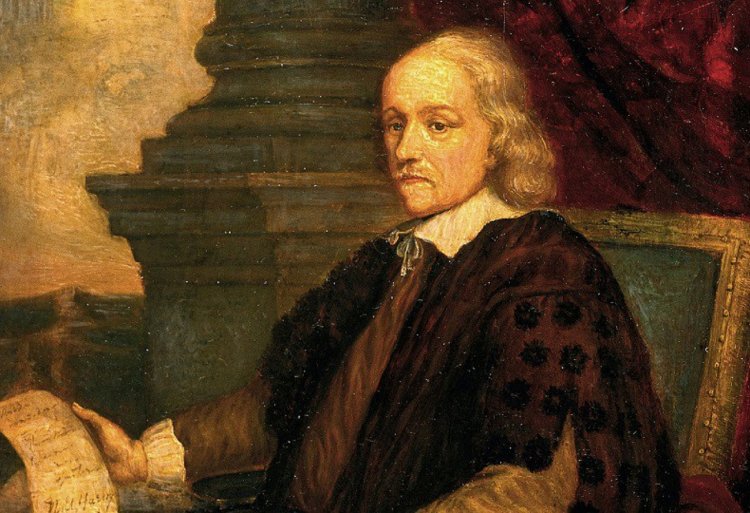Official:
William Harvey. 1 April 1578 – 3 June 1657. English physician, anatomist, pioneer of physiology and embryology. Discovered blood circulation.
Life and Work:
1. According to the writer Peter Ackroyd, William Harvey often watched fire fighters use pumps on the London streets. The scientist imagined a heart as a pump transporting the blood. This directed him to the discovery of the blood circulation in the human body.
2. A grandson of a sheep farmer in Kent and an eldest son of a merchant and a jurat of Folkestone showed remarkable academic excellence. According to surviving memories, the father was a smart person who decided that it would be reasonable for the boy to get good education and sent him to the King’s School, Canterbury, where William learned Latin and Greek.
3. The education of the future founding father of physiology and embryology looks impressive even these days let alone the late 16th century. He studied at the University of Cambridge where he chose subjects useful for the physician, including philosophy and mathematics, and at the University of Padua, renowned for its medical school.
4. During the first year of study in Padua, his teacher, professor Girolamo Fabrizio, or latinized Hieronymus Fabricius, published De Venarum Ostiolis. Even though the professor showed that entries into valves of veins are always open towards the heart, he did not see any correlation with the blood circulation. Nevertheless, Fabrizio’s works and demonstrations had a profound impact on the inquisitive English student.
5. In early 1603, the newly-made doctor of medicine of the University of Padua returned home. Having received all the necessary degrees and licenses in England, he started practice in London.
6. As an inquisitive man of action, Harvey engaged in private practice and served as a physician at Saint Bartholomew’s Hospital which was very prestigious during his time, worked at the College of Physicians and made his own experiments.
7. Back in the 1580s, Lord John Lumley was concerned with the medical education in England and established the so-called Lumleian Lectures. William Harvey served as a Lumleian lecturer for forty-one years.
8. On 16 April 1618, William Harvey gave a public Lumleian lecture which blew the attendees’ minds. It appears that the blood moves in a circle in the body, or, to be more accurate, in two circles - small or pulmonary and big or systemic. Harvey was first in the modern world to realize that the blood goes round in circles continuously instead of moving like tides.
9. The heart is a pump, Harvey claimed. It pumps the blood through arteries into tissues. The blood then returns to the heart through veins, going through lungs to capture oxygen and back to tissues.
10. It would be wrong to tell that the attendees understood and believed everything straight away – the prominent scholars of the time met William Harvey’s discovery with hostility. Hinting at Harvey’s major discovery, his opponents gave the physician an insulting name of the “circulator” which was given to wandering healers, i.e., charlatans.
11. By the time Harvey discovered circulation, the list of his patients included nobility and the highest-ranking patient was king James I. Bad reviews slightly tarnished reputation of the famous physician and led to a decrease in his private practice but the scholar remained a royal physician. James I was succeeded by Charles I and Harvey became his archiater.
12. Charles I got intrigued in Harvey’s research and provided him with carcasses of animals killed during the hunt. In 1645, the king appointed Harvey warden of Merton College, Oxford. But in June 1646, Oxford was besieged and stormed by Cromwell’s supporters and the scholar’s university career ended.
13. William Harvey visited Europe during the Thirty Years’ War. On his three-year journey with the high-ranking patient, the scientist continued his studies. In one of his letters, Harvey lamented about the miserable conditions in countries he visited: “By the way we could scarcely see a dog, crow, kite, raven, or any bird, or anything to anatomize.”
14. Harvey’s court career ended during the civil wars in England. His scientific work however continued. He was focused on the studies in the field of embryology and wasted so many eggs for science that there would be enough to cook fried eggs for all the Englishmen at once, Harvey’s cook said.
15. Harvey’s paper, Exercitatio Anatomica de Motu Cordis et Sanguinis in Animalibus, Latin for An Anatomical Exercise on the Motion of the Heart and Blood in Living Beings, was published in 1628 in Frankfurt. In 1651, he published his second major work, Exercitationes de Generatione Animalium, Latin for On the Generation of Animals. In this book, Harvey generalized the findings of his studies of many years in the embryonic development of invertebrate and vertebrate animals.
16. Harvey claimed that the egg is something that all the animals share initially and all life comes from the egg. Harvey’s studies on embryology became a major boost to the development of the theoretical and practical obstetrics.
17. Harvey had no children and, therefore, he left all his money for his relatives and the Royal College of Physicians for scientific studies.






















